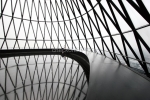Air Flow: Aqua Tower + Swiss Re
by ReniYoung
Prevailing winds have positive and negative pressure and air will always move toward negative pressure. As a result the wind is stonger in the sky than it is on the ground and skyscrapers have to be adapted to withstand this stronger wind. This thererfore encourages architects to design a profile of buildings so that there is laminar flow around them.
The Aqua Tower was designed by Jeanne Gang and is located in downtown Chicago. It is an 86-story mix use residential apartment and has some very interesting architectural elements due that came about by the consideration of these strong winds that will be blowing against the building surface. (images 1-3)
Projecting balconies to redirect the wind; these therefore disperse/breakup points of wind concentration to reduce its impact on the building
Balconies are place in pools of calmer air so that people higher up in their apartments can enjoy the outdoor space without the risk of getting blown off!
Note: Most intense winds happen on the corners of skyscrapers while mid-faces are calmer.
The idea of laminar flow around tall buildings reminded me of my CAAD project case study, the Swiss Re (also know as the Gherkin) in the U.K. A building like this would need to be curved rather than have sharp edges because the wind is less turbulent on the curves therefore encouraging a more smooth flow along the sides of the building. (images 4-7)






